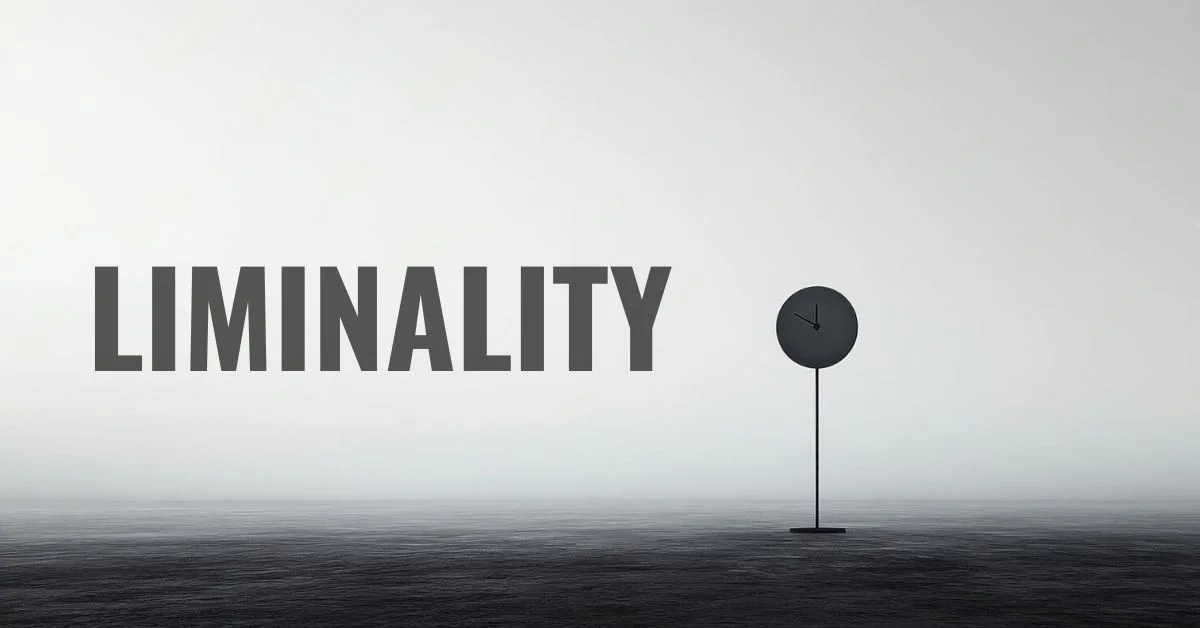GENERAL
Liminality Explained: The Space Between Meaning and Nihilism

Introduction to Liminality
Liminality is a word that might dance on the edge of your consciousness but often escapes clear definition. It refers to those peculiar moments when we find ourselves suspended between two states, caught in an ambiguous space where transformation occurs. This concept beckons us to explore the “in-between”—a realm filled with uncertainty and potential.
Imagine standing at a threshold, whether it’s during a life transition or while navigating societal changes. Liminality invites curiosity about what happens in this fragile balance between meaning and nihilism. It’s not just philosophical jargon; it reflects our everyday experiences. As we delve into this fascinating topic, we’ll uncover how liminality shapes our lives, culture, and psyche. Join me as we journey through these intriguing spaces that can spark creativity, self-discovery, and profound understanding of who we are amidst change.
Defining the In-Between Space
Liminality encapsulates the essence of transition. It is that peculiar state where one thing shifts into another, yet remains suspended in uncertainty.
Imagine standing on a bridge, half in one world and half in another. This space can feel both exhilarating and disorienting. The familiar fades while the unknown looms ahead.
In these moments, we often experience profound changes within ourselves. Our perceptions shift as we navigate this threshold.
This “in-between” becomes fertile ground for transformation and creativity. Here, old identities dissolve, making way for new possibilities.
We may find ourselves questioning beliefs or exploring uncharted emotions during these times of liminality. It’s a dance between what was and what could be—an invitation to explore the depths of our existence without clear direction or answers.
ALSO READ: EVERYTHING ABOUT vy6ys
The Historical Roots of Liminality
Liminality has deep historical roots, weaving through various cultures and philosophies. The term itself emerged from the field of anthropology. Arnold van Gennep introduced it in relation to rites of passage, highlighting transitional phases between social statuses.
Ancient rituals often marked significant changes in life—birth, marriage, death—all filled with uncertainty and transformation. These moments were not just transitions; they were spaces where individuals could redefine their identities.
In religious contexts, liminality appears as a threshold between sacred and profane realms. This duality is evident across multiple traditions—from ancient Greek mysteries to contemporary spiritual practices.
Philosophically, thinkers like Victor Turner expanded on these ideas by examining how societies navigate change through collective liminal experiences. His work emphasizes the importance of community during these transformative times, reflecting our shared human journey through life’s uncertainties. Each historical layer adds depth to our understanding of this unique state we encounter today.
Examples of Liminal Spaces in Culture and Society
Liminal spaces can be found in various aspects of culture and society. Think of the transition zones like airports or train stations. These places are neither here nor there, bustling with people on their journey to somewhere else.
Art also captures this essence vividly. Surrealist paintings often depict dreamlike landscapes that evoke a sense of uncertainty, existing between reality and imagination.
Literature embraces liminality too. Many coming-of-age stories explore characters navigating the thin line between childhood innocence and adult responsibilities, creating an emotional tension that resonates deeply.
Rituals serve as another example. Initiation ceremonies mark significant life changes but linger in a space where one is no longer who they were yet not fully what they will become.
These examples highlight how liminality shapes our experiences, offering unique opportunities for reflection and growth within cultures worldwide.
ALSO READ: Memento Vivere Tattoo: A Timeless Reminder
The Psychological Effects of Liminality
Liminality can stir a complex mix of emotions. When we find ourselves in this transitional space, feelings of uncertainty often arise. The ambiguity can lead to anxiety as we grapple with the unknown.
Yet, there’s another side to this experience. In moments of liminality, individuals frequently unlock creativity and introspection. With familiar structures stripped away, new ideas have room to blossom.
This state also encourages personal growth. As we navigate through these uncertain times, resilience builds within us. We learn to adapt and embrace change rather than resist it.
Moreover, liminal experiences can foster connection with others who share similar transitions. This sense of community becomes a powerful source of support amidst confusion.
Understanding the psychological effects of liminality helps us appreciate its role in our lives—a catalyst for transformation and self-discovery waiting just beyond the threshold.
How to Embrace and Navigate the Liminal Space?
Embracing liminality starts with acceptance. Acknowledge that uncertainty is part of growth. Recognize that this in-between state can be uncomfortable, but it’s also transformative.
Practice mindfulness to stay grounded. Focusing on the present moment reduces anxiety about the future or regret from the past. Engage in breathing exercises to center yourself during chaotic times.
Creativity thrives in liminal spaces. Use this opportunity to explore new hobbies or projects without fear of judgment. Allow yourself to experiment and play.
Connect with others who understand your journey. Sharing experiences can provide comfort and insight, reminding you that you’re not alone in navigating these uncharted waters.
Keep a journal to document your thoughts and feelings during this period. Writing can clarify emotions and reveal patterns over time, helping you find direction amidst ambiguity.
ALSO READ: Sumosearch Explained: How It Enhances Your Online Search Results
Conclusion: Finding Meaning in the In-Between
Liminality is a fascinating and complex concept that invites us to explore the spaces between certainty and uncertainty. In these moments of transition, we may feel disoriented or confused. Yet within this confusion lies an opportunity for growth and discovery.
Navigating through liminal spaces demands courage. It calls for embracing discomfort while allowing ourselves to be vulnerable. As we stand at the crossroads of meaning and nihilism, we can choose to find significance in our experiences.
In engaging with our own liminality, we might uncover new perspectives that enrich our lives. We learn resilience as we adapt to change, transforming challenges into stepping stones toward self-awareness.
Finding meaning in the in-between allows us to appreciate life’s nuances more deeply. So rather than fearing those transitional phases, let’s open ourselves up to their possibilities and revel in the beauty of not knowing what comes next.
ALSO READ: Översägt: Unveiling a Nordic Linguistic Gem
FAQs
What is Liminality?
Liminality refers to the transitional state between two phases of existence or understanding. It’s the space where things are in flux, neither here nor there, and is often characterized by uncertainty and transformation. This concept can apply to personal experiences, societal changes, or cultural practices where a shift is happening, but the outcome is not yet clear.
How does Liminality influence personal growth?
Liminality creates a space where familiar structures are removed, allowing for self-reflection and creativity. During these times, individuals may experience growth as they navigate uncertainty, adapt to new possibilities, and explore their identities in new ways. It can be a fertile ground for personal transformation and resilience.
Can you provide examples of liminal spaces in everyday life?
Yes, common examples include airports, train stations, or even the transitional period of moving to a new city. These places and moments are marked by the sense of being between destinations or states, embodying the essence of liminality with their temporary and transitional nature.
What historical significance does Liminality have?
Historically, liminality has been crucial in rites of passage and religious rituals. Arnold van Gennep first used the term to describe the transitional phases individuals undergo during ceremonies like initiations or marriages, where they move from one social status to another, often experiencing a period of ambiguity and transformation.
How can one effectively navigate a period of Liminality?
Navigating liminality involves embracing uncertainty and focusing on the present moment. Practices such as mindfulness, creativity, and connecting with others who share similar experiences can help. Keeping a journal to document thoughts and feelings can also provide clarity and direction during these transitional times.
GENERAL
Fibahub: Empowering Basketball Enthusiasts for the Future

Introduction to Fibahub and its mission
If you’re a basketball enthusiast, you know how important it is to stay connected with the sport you love. Enter Fibahub—a revolutionary platform designed specifically for players, coaches, and fans alike. With a mission to empower individuals within the basketball community, Fibahub is changing the way we engage with this thrilling game. Whether you’re looking to improve your skills, connect with other players or access valuable resources, this innovative hub has got you covered. Let’s dive into how Fibahub is shaping the future of basketball and why it should be on your radar!
The Rise of Basketball in Recent Years
Basketball has surged in popularity over the last decade. This rise can be attributed to various factors, including increased visibility through media and social platforms.
The NBA’s global reach has played a significant role. International games and star players like LeBron James have captivated audiences worldwide. Young fans are more engaged than ever, often sharing their love for the sport on social media.
Youth programs and grassroots initiatives are thriving. Schools and communities promote basketball as an accessible sport, encouraging participation at all levels.
Moreover, technological advancements enhance how fans experience the game. Streaming services allow viewers to watch matches from anywhere, further fueling interest in basketball culture.
As a result of these influences, local courts buzz with activity daily. The future looks bright for this dynamic sport as it continues to capture hearts globally.
The Impact of Technology on the Sport Industry
Technology has revolutionized the sports industry in ways we never imagined possible. From advanced analytics to virtual reality training, every aspect of the game is enhanced.
Fan engagement has transformed dramatically. Social media platforms and mobile apps bring fans closer to their favorite teams and players than ever before. Live streaming allows for real-time access to games across the globe.
Wearable technology plays a pivotal role as well. Athletes can monitor their performance metrics with precision, leading to better training regimens and injury prevention strategies.
Moreover, data-driven insights are reshaping coaching approaches. Decisions based on comprehensive statistics elevate team strategy, creating a more competitive atmosphere on the court.
The emergence of e-sports adds another layer, attracting younger audiences who may not traditionally engage with physical sports. This integration highlights how technology is expanding our understanding and enjoyment of basketball today.
ALSO READ: Legendary Rivalries: The Story of NFC East History
How Fibahub is Changing the Game
Fibahub is redefining how basketball enthusiasts connect and engage. By leveraging cutting-edge technology, it transforms traditional gameplay into a dynamic digital experience.
This platform fosters community building like never before. Players can find local games, join teams, or even challenge others in their area with just a few taps on their devices. The ease of connecting through Fibahub empowers users to stay active and improve their skills.
Moreover, the integration of analytics offers players insights that were previously inaccessible. Users can track their performance metrics over time and tailor their training sessions for maximum effectiveness.
Coaches also benefit significantly from Fibahub’s features. They gain access to tools that streamline communication with players while providing valuable resources for skill development. This collaborative environment nurtures talent at every level.
With its innovative approach, Fibahub is truly changing the game for both aspiring athletes and seasoned professionals alike.
Features and Benefits of Fibahub
Fibahub is packed with features designed for basketball enthusiasts of all levels. Users can access a wealth of training resources tailored to their skill sets, ensuring everyone finds something valuable.
The community aspect fosters connections between players, coaches, and fans. This interactive platform allows users to share experiences and insights, creating a supportive environment that thrives on collaboration.
Statistics tracking plays a vital role in player development. Athletes can monitor their progress over time, helping them identify areas for improvement.
Coaches benefit from advanced analytics tools that provide deeper insights into team performance. This data-driven approach enhances strategic planning during games and practice sessions.
With its user-friendly interface, Fibahub makes it easy for anyone to navigate the vast array of content available. Whether you’re seeking drills or game strategies, everything you need is just a click away.
ALSO READ: A Flashback to the Past: Retro Bowl Unblocked Games 911
Success Stories and Testimonials from Users
Fibahub has transformed the lives of many basketball enthusiasts, offering them a platform to connect and thrive. Users frequently share their stories of personal growth through engagement with the community.
One such user, Jake, discovered Fibahub after struggling to find local pickup games. Through the app, he not only joined nearby matches but also met lifelong friends who shared his passion for basketball.
Another testimonial comes from Sarah, who credits Fibahub with helping her improve her skills. She participated in online clinics hosted by experienced coaches and noticed significant progress in her game within weeks.
These success stories highlight how Fibahub fosters connections and promotes skill development. The platform’s impact resonates deeply within its community as users feel empowered to reach new heights in their basketball journey.
Future Plans for Fibahub
Fibahub is poised for an exciting future. The platform aims to enhance user experience through advanced features and seamless integration of new technologies.
One area of focus is expanding the community aspect. By introducing more interactive forums and live events, Fibahub plans to foster connections among basketball enthusiasts worldwide.
Additionally, they are exploring partnerships with prominent sports organizations. These collaborations could unlock exclusive content and training programs for users.
The introduction of personalized coaching tools is also on the horizon. This innovation will allow players at all levels to receive tailored guidance based on their unique skill sets.
There’s a keen interest in harnessing data analytics. Users will benefit from insights that help track performance trends over time, leading to informed decisions about training regimens.
All these endeavors show how dedicated Fibahub is to revolutionizing the basketball landscape for its community members.
Conclusion: Why Fibahub is the Ultimate Platform for Basketball Enthusiasts
Fibahub is more than just a platform; it’s a movement. By connecting basketball enthusiasts from all corners of the globe, it serves as a hub for talent development and community building. With an emphasis on technology-driven solutions, Fibahub empowers players at every skill level to enhance their game.
The features offered are designed with users in mind, ensuring that both amateur players and seasoned professionals can find value. From personalized training programs to networking opportunities with coaches and scouts, Fibahub addresses the diverse needs of basketball lovers.
Success stories echo throughout the community, demonstrating how this platform has changed lives by unlocking potential and creating new pathways in sports careers. As Fibahub continues to innovate and expand its reach, there’s no doubt that its impact will only grow stronger.
For those passionate about basketball—whether playing or coaching—Fibahub stands out as the ultimate resource. It fosters growth, connection, and inspiration within the sport we love so much.
ALSO READ: Why Futbolear is the Perfect Game to Enhance Your Soccer Skills
FAQs
What is Fibahub?
Fibahub is a revolutionary platform designed to connect basketball players, coaches, and fans. It offers resources, skill development tools, and a community for engaging with the sport.
How has Fibahub impacted the basketball community?
Fibahub has enhanced connectivity among players and coaches, provided valuable analytics for performance improvement, and created a supportive community for sharing insights and experiences.
What are some key features of Fibahub?
Key features include personalized training resources, community networking, performance tracking, and advanced analytics tools for both players and coaches.
How does technology influence Fibahub’s platform?
Technology enables real-time engagement, advanced performance metrics, and data-driven insights, revolutionizing how players train and interact with the basketball community.
What future developments are planned for Fibahub?
Future plans include expanding community interactions, partnering with sports organizations for exclusive content, and introducing personalized coaching tools for tailored guidance.
GENERAL
The Voice of Change: Myliberla Movement Explored

Introduction to Myliberla Movement
In today’s world, where freedom and equality are essential values, movements like MyLiberal are gaining momentum. Myliberla Movement is not just an organization; it’s a beacon of hope for those seeking social justice, individual freedom, and progressive change. With a clear mission and unwavering dedication, Myliberla stands as a powerful force for positive transformation.
The Origins of Myliberla Movement
Myliberla Movement traces its roots back to the fervent desire for liberty and justice for all. Born out of the need to address societal inequalities and promote inclusive policies, MyLiberal was founded on the principles of equality, democracy, and human rights. Its inception marked a turning point in the fight against oppression and discrimination, heralding a new era of activism and advocacy.
Key Figures and Influencers
At the helm of Myliberla Movement are visionary leaders and influencers who have dedicated their lives to the cause of liberation. From renowned activists to grassroots organizers, these individuals have spearheaded efforts to effect meaningful change and challenge the status quo. Their relentless determination and unwavering commitment have been instrumental in shaping the course of the movement and inspiring millions around the world.
ALSO READ: EXPLORING THE VITAL ROLE OF BACK CASTING ROOM
Core Values of Myliberla Movement
Central to the ethos of Myliberla Movement are its core values of equality, justice, and freedom. MyLiberal believes in the inherent worth and dignity of every individual, regardless of race, gender, or socioeconomic status. It advocates for equal rights and opportunities for all, striving to create a society where everyone can thrive and fulfill their potential without fear of discrimination or prejudice.
Campaigns and Initiatives
Myliberla Movement is not merely a theoretical concept; it’s a catalyst for tangible change. Through its various campaigns and initiatives, Myliberla has championed causes ranging from civil rights and environmental justice to healthcare reform and LGBTQ+ rights. Its grassroots approach empowers communities to take action and make a difference, leading to significant victories and lasting impact.
Challenges and Criticisms
Despite its noble intentions, Myliberla Movement has faced its fair share of challenges and criticisms. From political opposition to internal disputes, navigating the complex landscape of activism is no easy feat. However, MyLiberal remains steadfast in its commitment to transparency and accountability, addressing concerns head-on and striving to learn and grow from feedback.
ALSO READ: OLLYHIBS: THE ULTIMATE BALANCE CHALLENGE
Global Reach of Myliberla Movement
While rooted in local communities, Myliberla Movement has a global reach, with chapters and alliances spanning continents. Its message of freedom and justice transcends borders, resonating with people from diverse backgrounds and cultures. By forging international partnerships and fostering cross-cultural solidarity, MyLiberal continues to make waves on the global stage.
Empowering Communities
At the heart of Myliberla Movement is the belief in the power of grassroots activism. By empowering communities to advocate for change from the ground up, MyLiberal fosters a sense of ownership and agency among its members. Through community organizing and outreach efforts, MyLiberal seeks to amplify the voices of those most affected by injustice and marginalization.
ALSO READ: KINGYMAB: WHERE FITNESS MEETS FUN
Technological Integration
In an increasingly digital world, Myliberla harnesses the power of technology to mobilize supporters and amplify its message. From social media campaigns to online organizing tools, MyLiberal leverages technology to connect with a broader audience and facilitate collective action. By embracing innovation, MyLiberal remains at the forefront of twenty-first-century activism.
Achievements and Milestones
Over the years, Myliberla Movement has achieved numerous milestones and victories, from landmark legislative wins to grassroots triumphs. Whether securing equal rights for marginalized communities or advocating for environmental sustainability, MyLiberal’s impact is undeniable. These achievements serve as a testament to the dedication and resilience of MyLiberal’s supporters and activists.
ALSO READ: CÑIMS EXPLAINED: INNOVATION REDEFINED
Future Prospects and Goals
Looking ahead, Myliberla Movement remains committed to its long-term vision of a more just and equitable society. By expanding its reach, diversifying its initiatives, and strengthening its partnerships, MyLiberal seeks to build on past successes and tackle new challenges head-on. With unwavering determination and collective action, the future of MyLiberal is bright and full of promise.
Support and Membership
Joining Myliberla Movement is more than just signing up; it’s a commitment to a shared vision of freedom and justice for all. Whether through volunteering, donating, or spreading awareness, there are countless ways to get involved and make a difference. As a member of MyLiberal, you’ll have access to a vibrant community of like-minded individuals and opportunities to contribute to meaningful change.
Impact on Youth and Education
One of the most exciting aspects of Myliberla Movement is its impact on youth and education. Through initiatives in schools and universities, MyLiberal inspires the next generation of leaders and changemakers. By providing resources, training, and mentorship, MyLiberal empowers young people to become active participants in shaping their futures and creating a more just society.
ALSO READ: SÜBERLIG: THE PREMIER LEAGUE OF EXCELLENCE AND COMMUNITY
Collaborations and Partnerships
MyLiberal Movement understands that real change requires collaboration and partnership. That’s why it actively seeks to work with other organizations and movements that share its values and goals. By pooling resources and expertise, MyLiberal can amplify its impact and effect meaningful change on a larger scale. Together, we are stronger.
Conclusion
In conclusion, Myliberla Movement is not just a movement; it’s a force for good in the world. Through its unwavering commitment to freedom, justice, and equality, MyLiberal has made a significant impact on society and politics. As we look to the future, let us continue to stand together in solidarity, united in our shared vision of a better world for all.
ALSO READ: EXPLORING KÄÄTÄNÄJ: A JOURNEY INTO CULTURAL RICHES
FAQs
How can I get involved with Myliberla Movement?
You can get involved by volunteering, donating, or spreading awareness about MyLiberal’s initiatives and campaigns. Visit our website for more information on how to take action.
What sets MyLiberal Movement apart from other organizations?
MyLiberal Movement is unique in its grassroots approach and commitment to inclusivity and social justice. We prioritize community engagement and empowerment, ensuring that everyone has a voice in the fight for freedom and equality.
Does MyLiberal Movement have chapters in other countries?
Yes, MyLiberal Movement has chapters and alliances in countries around the world. Our message of liberation knows no borders, and we work collaboratively with activists and organizations globally to effect positive change.
How does MyLiberal Movement use technology in its advocacy efforts?
MyLiberal Movement utilizes technology to mobilize supporters, organize campaigns, and amplify our message on social media platforms. We also leverage digital tools for online advocacy and fundraising.
Can anyone join MyLiberal Movement, or are there membership requirements?
MyLiberal Movement welcomes individuals from all backgrounds who share our values and commitment to social justice. There are no specific membership requirements; anyone can join and contribute to our cause.
GENERAL
AFCconnect Decoded: Enhancing Direct Selling Success

Welcome to the gateway of revolutionizing your direct selling game – AFCconnect! If you’re looking to amplify your success in the world of direct sales, then you’ve stumbled upon the right place. AFCconnect is here to transform how you approach and excel in your direct selling endeavors. So, buckle up as we unravel the power-packed potential that AFCconnect holds for boosting your direct selling success!
Benefits of using AFCconnect for Direct Selling
Are you a direct seller looking to take your business to the next level? AFCconnect is here to help streamline your operations and boost your success. With AFCconnect, you can manage your inventory, track sales data, and communicate with customers all in one convenient platform.
One of the key benefits of using AFCconnect is its user-friendly interface that makes it easy for even the most tech-challenged individuals to navigate. Say goodbye to messy spreadsheets and disorganized notes – AFCconnect keeps everything neatly organized and accessible at your fingertips.
Another advantage of AFCconnect is its real-time analytics feature, allowing you to monitor sales trends, identify top-performing products, and make informed decisions based on data-driven insights. This valuable information empowers you to optimize your selling strategies for maximum profitability.
Moreover, AFCconnect offers seamless integration with social media platforms, making it effortless to promote your products and engage with potential customers online. By leveraging this connectivity, you can expand your reach and grow your customer base effectively.
In essence, utilizing AFCconnect opens up a world of possibilities for direct sellers seeking efficiency and growth in their businesses.
How to Set up and Use AFCconnect?
Setting up and using AFCconnect for your direct selling business is a breeze. To get started, simply download the app from the App Store or Google Play. Once installed, create your account by providing basic information about yourself and your business.
Next, familiarize yourself with the features of AFCconnect. From managing orders to tracking sales performance, this platform offers everything you need to streamline your direct selling operations. Take some time to explore its functionalities and see how they can benefit your business.
When it comes to using AFCconnect effectively, consistency is key. Make it a habit to update product listings regularly, respond promptly to customer inquiries, and analyze sales data to identify trends and opportunities for growth.
Don’t hesitate to reach out for support if you encounter any challenges along the way. The AFCconnect team is always ready to assist you in maximizing the potential of this powerful tool for direct selling success.
Tips for Maximizing Your Direct Selling Success with AFCconnect
Looking to take your direct selling game to the next level with AFCconnect? Here are some tips to help you maximize your success:
First, make sure to familiarize yourself with all the features and capabilities of AFCconnect. Understanding how this tool can streamline your business operations is key.
Set specific goals for your direct selling efforts using AFCconnect. Whether it’s increasing sales, expanding your network, or improving customer relationships, having clear objectives will keep you focused and motivated.
Next, leverage the data and analytics provided by AFCconnect to gain valuable insights into your performance. Use this information to identify trends, refine strategies, and make informed decisions moving forward.
Additionally, stay connected with other users in the AFCconnect community. Sharing experiences, tips, and best practices can offer fresh perspectives and inspiration for growing your business.
By implementing these tips effectively within the AFCconnect’s platform, you’ll be well on your way to achieving direct selling success like never before!
Case Studies: Real-Life Examples of Successful Direct Sellers Using AFCconnect
Unveiling real-life success stories of direct sellers leveraging AFCconnect’s sheds light on the platform’s transformative power. Let’s delve into these inspiring case studies to understand how AFCconnect’s has revolutionized their businesses.
Case Study 1: Sarah, a direct seller specializing in skincare products, saw a significant increase in sales after integrating AFCconnec’st. By utilizing its advanced analytics and customer management features, she personalized her approach and boosted customer loyalty.
Case Study 2: Mark, an independent distributor of health supplements, streamlined his operations with AFCconnect’s inventory tracking and order processing capabilities. This optimization led to improved efficiency and higher profitability for his business.
These examples illustrate how direct sellers across various industries have harnessed the potential of AFCconnect’s to drive growth and achieve their goals.
The Future of Direct Selling with AFCconnect
As we look ahead to the future of direct selling with AFCconnect’s, the possibilities are endless. With technology continuously evolving, this platform is set to revolutionize how direct sellers operate and succeed in the industry.
Imagine a world where real-time data analytics provide insights into customer behavior, allowing direct sellers to tailor their approach for maximum impact. AFCconnect’s has the potential to streamline processes, enhance communication with customers, and ultimately drive sales like never before.
With its user-friendly interface and innovative features, AFCconnect’s is poised to become an indispensable tool for direct sellers looking to stay ahead of the curve in a competitive market landscape. As more individuals recognize the benefits of leveraging this platform, we can expect to see a surge in success stories and thriving businesses built on its foundation.
The future of direct selling with AFCconnect’s is bright – full of opportunities for growth, expansion, and unparalleled success. It’s exciting to think about how this platform will continue to shape the industry moving forward.
Conclusion
AFCconnect is revolutionizing the world of direct selling by providing a powerful platform for distributors to streamline their business operations and maximize their success. By leveraging the benefits of AFCconnect, direct sellers can enhance their productivity, improve customer relationships, and ultimately boost their sales performance.
With its user-friendly interface, robust features, and real-time insights, AFCconnect empowers direct sellers to take their businesses to new heights. As more individuals and companies embrace this innovative tool, the future of direct selling looks brighter than ever before.
So why wait? Join the ranks of successful direct sellers who are using AFCconnect to transform their businesses today!
FAQs
What is AFCconnect?
AFCconnect is a comprehensive platform designed to enhance success in direct selling. It helps streamline operations, manage inventory, track sales, and engage with customers through an easy-to-use interface.
What are the benefits of using AFCconnect for direct selling?
AFCconnect’s offers real-time analytics, inventory management, and seamless social media integration. It helps direct sellers make informed decisions, optimize strategies, and expand their reach effectively.
How do I set up and use AFCconnect’s?
Download the app from the App Store or Google Play, create an account, and explore its features. Regularly update product listings, respond to customer inquiries, and analyze sales data for maximum effectiveness.
Can you provide tips for maximizing success with AFCconnect’s?
Familiarize yourself with AFCconnect’s features, set specific goals, use data analytics for insights, and connect with other users for shared experiences and tips to grow your business.
Are there real-life examples of success using AFCconnect?
Yes, numerous direct sellers have achieved significant success. For instance, Sarah increased sales by personalizing customer interactions, while Mark improved efficiency and profitability by optimizing inventory and order processes with AFCconnect.

 GENERAL4 months ago
GENERAL4 months ago5 Factors That Affect Tattoo Removal Success

 ENTERTAINMENT6 days ago
ENTERTAINMENT6 days agoExploring the Kristen Archives: A Treasure Trove of Erotica and More

 LIFESTYLE8 months ago
LIFESTYLE8 months agoThe Disciplinary Wives Club: Spanking for Love, Not Punishment

 TECHNOLOGY8 months ago
TECHNOLOGY8 months agoBlog Arcy Art: Where Architecture Meets Art

 LIFESTYLE2 months ago
LIFESTYLE2 months agoWho Is Sandra Orlow?

 ENTERTAINMENT10 months ago
ENTERTAINMENT10 months agoThe Ultimate Guide to Shillong Teer Hit Number: How to Predict Your Next Win

 GENERAL2 weeks ago
GENERAL2 weeks agoEverything About King Von Autopsy Report Details

 LIFESTYLE1 month ago
LIFESTYLE1 month agoWho Is Wife Crazy Stacie









